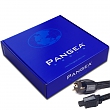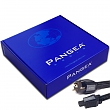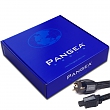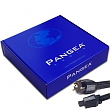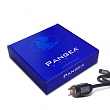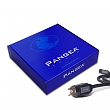AC-9SEMKII
The Best Affordable High-current AC Cable Just Got Way Better
The best affordable high-current AC power cable in the industry has just gotten a whole lot better. Pangea Audio's AC-9SE has been upgraded as the new model AC-9SE Signature Edition MkII to include premium Cardas Grade One Copper in its conductors. AC-9SE MkII is the AC power cable of choice, for getting superior performance from hi-fi and home theater amplifiers, powered subwoofers, and other high current AV components.
This cable is terminated with a high-quality Schuko-type AC plug common in many European countries.
The Pangea Audio AC-9SE Signature Edition power cable is an enhancement of Pangea's wildly popular AC-9 and the new AC-9 MkII power cables. In spite of its name, the AC-9SE MkII isn't a nine-gauge cable. It's actually a seven-gauge cable, which means it's even heftier than the nine-gauge! (The lower the gauge, the thicker the cable.)
This 7-awg design with its advanced combination of Cardas Grade One Copper conductors, OFC copper conductors, and Litz wire conductors offers a substantial upgrade compared to the already excellent AC-9 MkII. Furthermore, the AC9-SE MkII contains several times the amount of Cardas Grade One Copper than is used in the AC-9 MkII, and this makes a significant sonic difference.
"Quite Simply the Best Copper on the Planet"
The original version of AC-9SE used OFC, Long-Crystal Copper, Litz wire, and PCOCC copper conductors. The new MkII version goes a substantial step further, upgrading to a combination of 99.99% purity OFC copper, Litz wire, and – most important of all – no-compromise Cardas Grade One Copper, which George Cardas of Cardas Audio developed for his own premium cables.
George’s copper is mined in Arizona, then shipped to a New England factory where it is very S-L-O-W-L-Y drawn into conductors in a process that includes reduction annealing between steps to further purify and meld the copper into what George calls "the most amazing audio conductor I have ever experienced. It is quite simply the best copper on the planet."
"The bottom line is that the best phono cartridges manufactured in the world, the best transformer winders, and the best cable manufactures in the world are converting to this smooth sounding Cardas Grade One Copper," George reports.
"It is simply stunning how using a combination of space age technology (reduction annealing) and ancient drawing process (diamond dies and a slow multi stage annealing) can result in such a refined product."
The combination of Cardas Grade One Copper, OFC copper, and Litz wire conductors makes the AC-9SE MkII Signature Edition an amazing component for the money, outperforming audiophile power cables that cost far more. So throw away the cheap, stock AC power cable that came with your AV component and make the easy, affordable upgrade to AC-9SE MkII. It will bring out the best in your system.
Because of their high-current requirements, power amps benefit from heavier gauge conductors than normal power cords offer. The AC9-SE MkII is specially designed to deliver the clean, high-current power needed by audio amplifiers – including stereo, mono, multichannel, and integrated amps. It is also ideal for powered subwoofers, power conditioners, and other high-current electronic components.
DeathGrip™ IEC
One weak link in the power chain that is often overlooked is the IEC connector. We had found a good one for our Pangea cables. It had large contacts and gripped firmly. Then Jay Victor discovered another IEC connector with massive gold-plated contacts that gripped a component's IEC better than anything he had ever seen.
"It's like a death grip," reported Jay. "We need to use it on our high-end cables." We agreed with Jay, and the DeathGrip™ IEC was born.
Seven-Way Multi-gauge Geometry
The AC-9SE MkII uses different wire gauges consisting of a combination of Cardas Grade One Copper, OFC copper, and Litz wire copper conductors.
Counter-spiraled conductors offer superior noise rejection, and the triple-shielded design provides high-current noise isolation. The large-diameter 7-awg construction boasts seven-way multi-gauge geometry optimized for high-current delivery of 50/60 Hz AC power. The solid-blade 24k gold-plated copper AC contacts provide superior electrical contact.
The Inside Story of Pangea Audio MkII Cables
Pangea Audio's AC-14 was one of the first cables designed from the ground-up as a high quality power cable for audio gear. Veteran cable designer, Jay Victor, designed the AC-14 specifically for source components like preamps, CD players, DACs, etc. Jay kept the price low thanks to his expertise with manufacturing processes and materials and also by using high-integrity molded connectors. Introduced for only $30 for a 1.0-meter length, the AC-14 was intended as a replacement for the cheapo stock cable thrown in the box with almost any high-end audio gear.
Soon after the Pangea AC-14 was introduced, something unexpected happened. Audiophiles around the country began reporting that the inexpensive AC-14 sounded better than other upgrade power cables costing five to ten times the price. Word of the AC-14's excellent performance spread quickly among audiophiles. Over the next few years, more than ten thousand AC-14 cables were sold.
Birth of the AC-9 and Beyond
Pangea Audio's AC-14 was quickly followed by the AC-9. This massive seven-gauge cable was designed for the high-current demands of power amplifiers, powered subs, power conditions, and more. More advanced Pangea Audio cables soon followed. These newer cables featured better shielding and higher grades of copper for even better performance. These cables sold incredibly well until suddenly and without warning the Japanese manufacturer announced they were ceasing production of the two higher grades of copper used in these newer Pangea cables.
Now, what to do?
An American Solution to the Japanese Problem
With the Japanese copper unavailable, Pangea Audio discovered another form of premium copper that was being produced by industry legend George Cardas, founder of Cardas Audio. Some years earlier, George was unhappy with the quality of the copper conductors available for his high-end cables. He decided to produce his own high-end copper, which he calls Cardas Grade One Copper.
Starting with the best available electrolytic copper mined in Arizona, Cardas very S-L-O-W-L-Y draws the copper into conductors in a process that includes reduction annealing between steps to further purify and meld the copper into what George calls "the most amazing audio conductor I have ever experienced."
So what started out as a problem for Pangea Audio with the loss of premium Japanese copper has turned out to be a huge benefit now that the company has upgraded to no-compromise Cardas Grade One Copper.
Pangea Audio Power Cables
Pangea Audio power cables offer the perfect balance of power, shielding, and flexibility for audiophile components. These cables have been designed, not from the AC wall outlet to the component, but the other way around – from the component to the wall outlet. The result is a cable that not only fully satisfies the 'real power requirements' of audiophile components, but which also delivers improved performance for both power and component isolation.
Pangea's 'component to the wall outlet' design results in a better cable that's designed just for the component you want to power. The cable gives you precisely what you need - no more and definitely no less.
When More Is Sometimes Actually Less
Until now, all upgrade power cables have been designed according to a 'more is better' philosophy, leading manufacturers to increase the diameter of the conductor and the thickness of the insulation in an attempt to improve performance, but at the expense of flexibility. The resulting thick, noncompliant cables put a severe strain on the chassis of connected components.
Heavy, inflexible cables can also reduce the effectiveness of component isolation and suspension systems. Because power amps do benefit from heavier gauge conductors, the AC-9SE MkII is thicker than its smaller sibling, the AC-14. However, it is only as thick as it needs to be for maximum performance, and it is still more flexible than competitive AC power cords.


